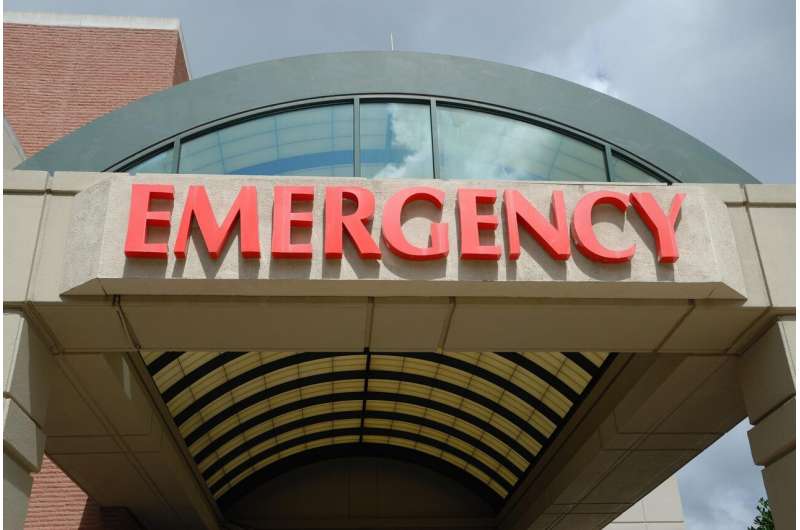This article has been reviewed according to Science X's editorial process and policies. Editors have highlighted the following attributes while ensuring the content's credibility:
fact-checked
trusted source
proofread
Nitrous oxide helps relieve kids' pain and distress in emergency rooms, study shows

Inhaled nitrous oxide, better known as laughing gas, should be used more widely to manage children's pain and distress when they undergo emergency treatment in hospitals, says a University of Alberta expert.
"The more we can do for children to improve their pain experience in the emergency department—which is often their first exposure to health care in a crisis—the better they will cope as older children on repeat visits and as adults," says Samina Ali, professor of pediatrics and emergency medicine in the Faculty of Medicine & Dentistry and pediatric emergency physician at the Stollery Children's Hospital.
Nitrous oxide is widely used in dental offices, in hospitals for labor and delivery, and by paramedics. But its use in pediatric emergency departments is still limited in Canada, resulting in many children suffering unnecessary pain and sometimes leading to issues with needle phobia.
Ali is part of the national research group Pediatric Emergency Research Canada (PERC) and is the Western Canada hub lead for Solutions for Kids in Pain, both of which are supported in part by Stollery Children's Hospital Foundation. Ali and colleagues in the group recently published a review of Canadian clinical trials where nitrous oxide was used for pain management in pediatric emergency centers.
Safe and effective for kids in the ER
The research review, led by Naveen Poonai and published in the Canadian Journal of Emergency Medicine, is one of four studies Ali and her colleagues are conducting to gather evidence to guide safe nitrous oxide use for children in Canada. Six out of 10 children arrive in pediatric emergency departments with painful conditions, Ali says, and pain management remains a huge challenge in many settings.
The group's recent study looked at 30 clinical trials where inhaled nitrous oxide was used, mainly during IV insertion or laceration repair using stitches. The evidence from the trials shows that it is safe and effective when used during IV insertion, especially in conjunction with numbing creams. It is also a good option during laceration repair, although the researchers plan to study this further.
"By using nitrous oxide, which doesn't involve a needle and doesn't involve having to swallow a medication—both of which can be tremendously challenging for children—we're able to manage their pain in a way that's less invasive and contributes to less stress for them," says Ali, who is also a member of the Women and Children's Health Research Institute and a co-author of Canada's first national pediatric pain management standard, released this year.
Alleviating needle phobia has lifelong benefits
Pediatric pain management in the emergency department has ramifications beyond providing comfort for children and relieving their families' stress. Ali says up to 1 in 10 adults suffers from needle phobia, a condition that can include both psychological and physiological symptoms. "It's a real problem," says Ali, "and it starts in childhood."
Needle phobia can prevent people from getting immunized or seeking treatment for infectious diseases. "We've seen the results of needle phobia with COVID. When we asked adults, 'Why aren't you getting your vaccines?' a good number of them said it was because they didn't like needles."
Treating a child's pain with nitrous oxide during some painful procedures is a win-win for patients, health-care providers and hospital administrators, says Ali. It is effective, safe, inexpensive, can be readily available and is easy to administer through an on-demand mouthpiece or continuous-flow mask for the youngest patients.
However, a recent survey by the PERC researchers shows that less than half of Canadian pediatric emergency physicians are using nitrous oxide to treat children's pain and distress in the emergency department, mostly because it wasn't available at their site.
That study, which will be published this fall, also shows that nitrous oxide was being used in only 6 of 15 Canadian pediatric emergency hospitals in 2021—including the two in Alberta.
Ali is hopeful that, once their research is shared more widely, they can increase that number to double digits in the next five years.
"Part of this process is sharing the knowledge with families so they are empowered to advocate for their child and ask about using nitrous oxide for pain and anxiety."
More information: Naveen Poonai et al, Inhaled nitrous oxide for painful procedures in children and youth: a systematic review and meta-analysis, Canadian Journal of Emergency Medicine (2023). DOI: 10.1007/s43678-023-00507-0

















